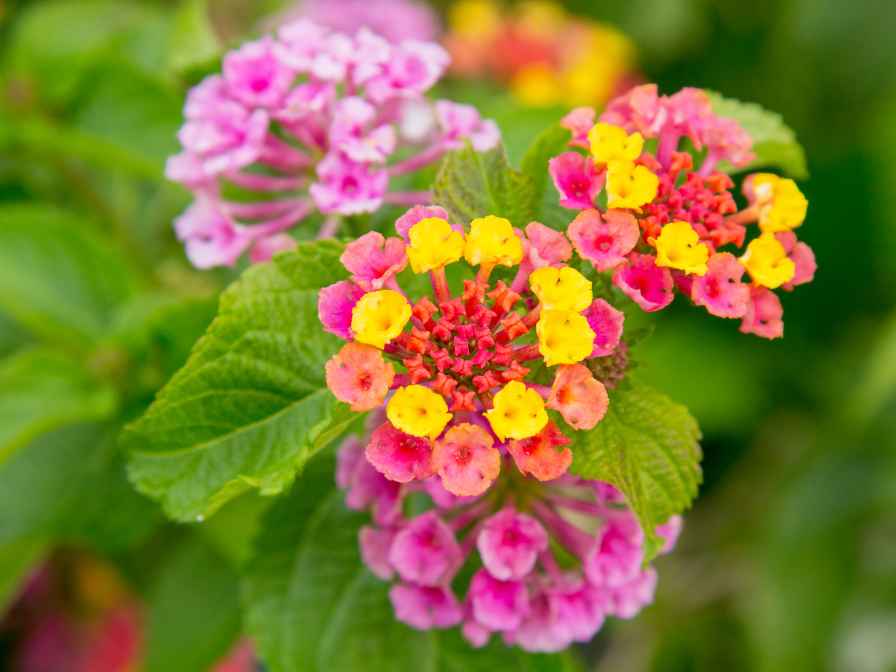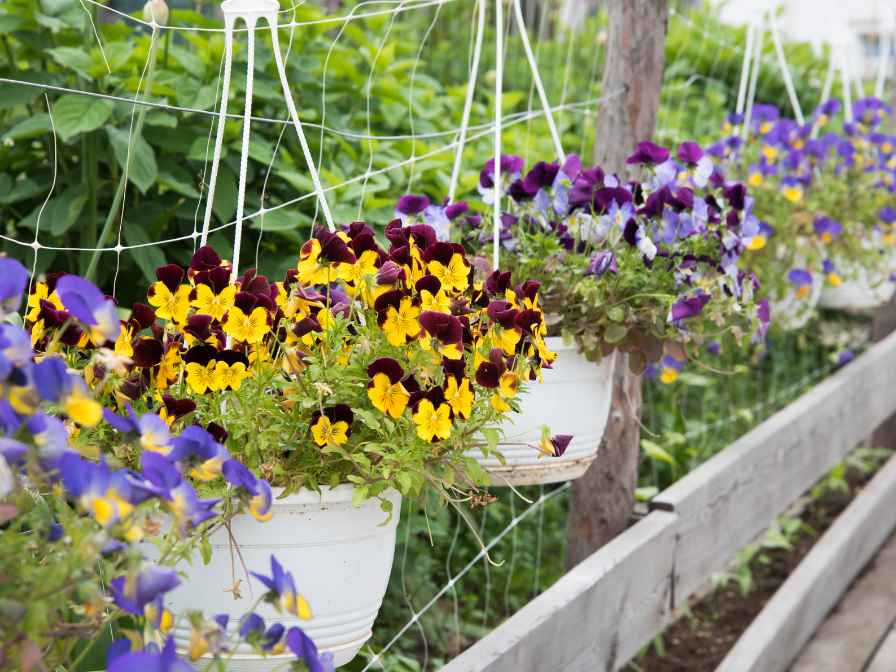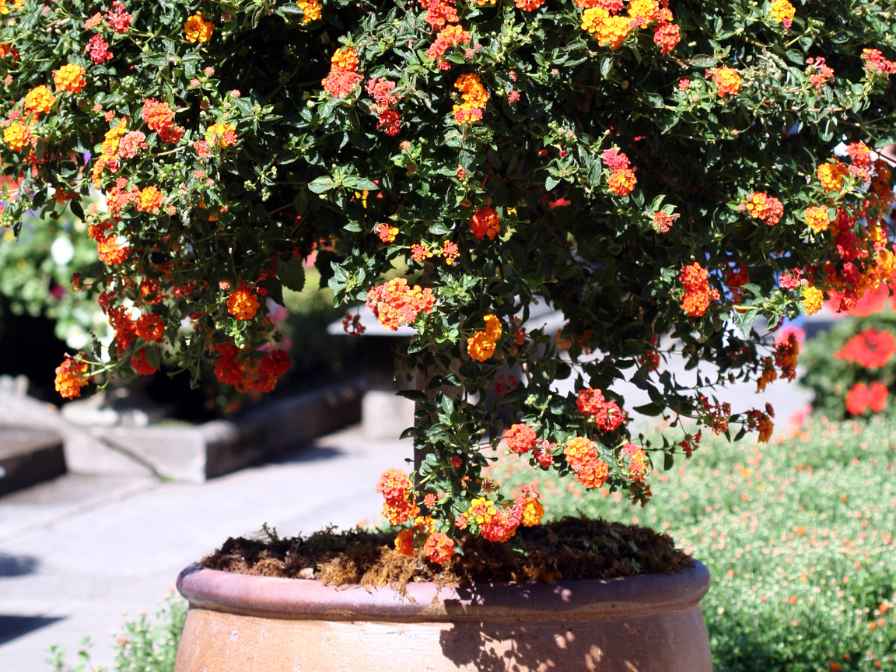Gardeners and homesteaders do look for plants and trees which can be mutually beneficial for each other. These are such plants that can act as companion plants as well as benefit in other ways like fruiting, shades, etc.

But when there is a question to get the most out of the pollinator as well as a good companion plant there comes the lantana. Lantana plants attract a good amount of pollinators while acting as good companion plants. That’s why we are going to discuss what to plant with lantana in a container.
Lantana plants
Lantana plants belong to the verbenacae family of verbena, a perennial flowering plant. Native to tropical areas of Africa, and the Americas, these are known as ornamental plants.
Lantanas are prized for their brightly colored, usually sweet-scented, flower clusters and attractive foliage. They grow well in warm climates and can be grown as shrubs or groundcovers. These should be treated as poisonous for pets and humans. It has many colors.
Some species of lantana can become invasive in some areas, so it is important to check if they are considered invasive in your region before planting. It can be used as an advantage as well as a disadvantage.
Since mentioning the lantana plants, there are many benefits of planting the lantana plants as a companion plants. Some of these benefits are as follows:
Lantana Attracts Wildlife
Lantana is a popular nectar source for butterflies, hummingbirds, and other pollinators. It will increase the yield of plants by being well-pollinated.
Low Maintenance
Lantana is a tough and hardy plant that requires little care and maintenance. It can face the little frost as well. It is a hard plant but, can die due to overwatering. Lantana is a drought-tolerant plant that can survive in hot, dry conditions.
Versatile
Lantana is a versatile plant that can be used in various landscapes, such as borders, ground covers, hanging baskets, and rock gardens. You can use it to make sure of the ornamental value at all places. Lantana has colorful and vibrant flowers that can add beauty and interest to any landscape. It has flowers of many colors.
Invasive
In some areas, lantana can become invasive and spread quickly, so it is important to keep an eye on its growth and spread. It can be used as a benefit as well. If you want to use it as a fast-growing vein to cover, it can be used effectively.
Companion Planting in Containers
The act of cultivating various plant species next to one another for mutual benefit is known as companion planting. This can be done by promoting plant growth, preventing pests and illnesses, or raising soil fertility.
Tomatoes and basil, which may enhance the flavor of tomatoes, are two examples of typical companion plants. Marigolds, which can help ward off pests like nematodes in the soil, are another. You might argue that these pants work together like complementary plants. They do help each other grow in a healthy way.
Benefits of Planting Plants as Companions
The advantages of companion planting are numerous. The designed gardens adhere to this conventional procedure. In addition to adding plants, it increases the garden’s worth. These plants work in harmony with one another. The following are a few of the advantages:
Reduced chemical pesticides
Because certain plants naturally resist pests, companion planting can help minimize the need for chemical pesticides. Some plants serve as a false front for others. They keep birds, wild animals, and hazardous pests away from the plants.
Better Soil Health
By incorporating nitrogen and other nutrients into the soil, companion plants can increase soil fertility while lowering erosion and enhancing water retention. Some plants, like beans, take significant amounts of nitrogen from the air and release it into the soil.
Biodiversity
In the garden, companion planting can boost biodiversity, resulting in a more wholesome and dynamic ecology. Each plant component is essential to the others. They create an ecology that is safer and healthier for all of the garden’s plants.
Pest Prevention
Some plants have the power to deter pests, guard against illness in other plants, or draw helpful insects that can reduce pests. In the same way, they promote cross-pollination by luring beneficial insects and bees. Additionally, they deter dangerous insects.
Higher yields
By offering shade, lowering rivalry for light, water, and nutrients, attracting pollinators, or removing competition altogether, companion planting can enhance the development and yields of some crops. The companion plants also serve as a place for the other plants to hide.
Companion planting, in brief, is a helpful strategy for organic gardening that may raise plant production and health while minimizing the harm chemical pesticides do to the environment. The gardener benefits since there are more plants and they are also safer and healthier.
What to Plant with Lantana in a Container?

Lantana is a tropical plant that grows well in containers and can be paired with several other plants that have similar growing conditions. There are many good options available in the market. some of the important ones are as follows:
Calibrachoa with Lantana
Calibrachoa and lantana can make good companion plants in gardening. Both of these plants are known for their vibrant, showy flowers and ability to attract pollinators like hummingbirds and butterflies.
Calibrachoa is a trailing plant that can spill over the sides of hanging baskets or pots, while lantana provides upright growth and larger flowers, making them a complementary pairing.
Petunia with Lantana
Petunias come in a wide range of colors and are often used in hanging baskets or pots for their trailing habit, while lantana provides upright growth and more prominent flowers. When combined, the two plants can create a beautiful, eye-catching display of color in mixed containers or garden beds.
Just be aware that both petunias and lantana can be invasive in some regions. Prune them well, or keep a keen eye on their growth.
Verbena and Lantana
Verbena has almost the same nature as the lantana plants. You can plant it with it. They both complement each other. Be aware these are invasive. They can grow very fast. They both attract pollinators.
Coleus and Lantana
Coleus has brightly colored foliage and can complement the colorful blooms of Lantana. Additionally, both plants prefer similar growing conditions such as well-drained soil and partial to full sunlight. This combination can create a visually appealing garden or landscape design.
Impatiens
They both prefer similar growing conditions (moist, well-drained soil and partial to full shade) and can complement each other with their bright, colorful blooms. Impatiens also have a relatively low-growing habit, so they won’t shade out the lantana. It’s important to note that both impatiens and lantana are annuals in many climates.
Heliotrope
Heliotrope releases a natural allopathic substance that repels certain insect pests, which can help protect lantana from damage. Additionally, the heliotrope’s attractive flowers and sweet fragrance can complement the bright colors and blooms of lantana, creating an attractive and thriving garden.
When choosing plants to grow with lantana, look for those that prefer similar lighting and watering conditions. Keep in mind that lantana can become invasive in some areas, so be sure to choose plants that are well-behaved and won’t take over the container. Or you can prune it effectively to keep it in a shape.
Cautions while Planting Companion Plants

However, companion planting should be done to make the most use of available space and preserve the plants’ safety and health for the least amount of money. Some of the cautions include the following:
Check that the conditions for the companion plants’ growth, such as those for light, water, and soil, are appropriate. They shouldn’t include any contrast. It could cause harm to any plant.
To avoid overpopulation or resource competition, be aware of each plant’s mature size and development trend. similar to how one plant could obstruct the development of another by occupying its space.
Choose your plants carefully, and be ready to remove any that turn out to be a problem since certain species can grow invasive and take over the garden. To maintain them in shape and under control, prune them frequently.
A plant may emit compounds that prevent the development of other plants; keep this in mind if any possible allopathic effects occur. The chosen plants should cooperate with one another in every manner.
Take into account plants’ seasonality to ensure that their development cycles complement one another. One plant may not be in its dwarf phase while another is in its bloom phase. In that situation, they may provide each other with a competitive advantage.
When applying any remedies to your garden, keep in mind that pesticides and other substances that are harmful to one plant may be harmful to companion plants. Other plants might be harmed or even burned to the ground.
In short, the lantana plants are good to plant. These plants benefit the gardens in many ways. They attract a good amount of effective pollinates. Just make sure to prune it so that it remains in shape.

